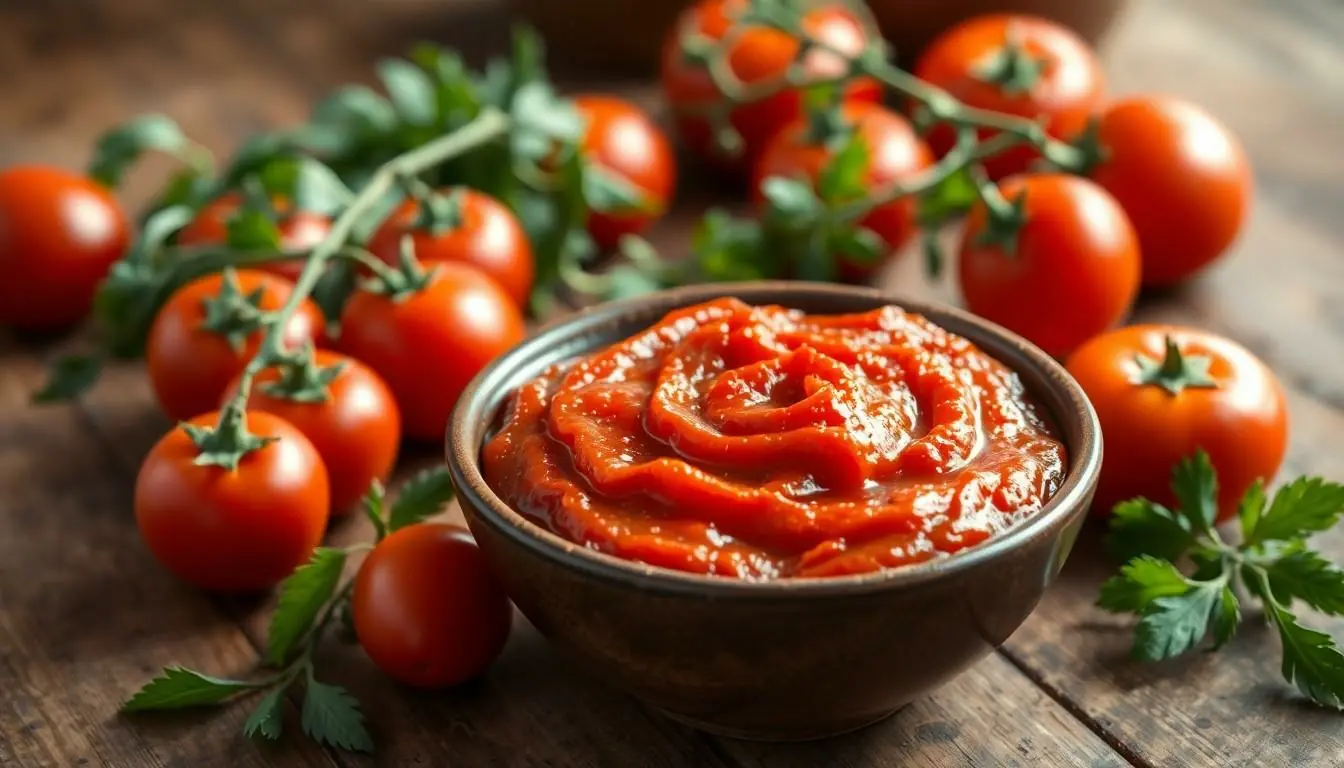Table of Contents
ToggleTomato paste might not be the star of the culinary show, but it’s certainly the unsung hero lurking in the pantry. Packed with flavor and nutrients, this thick, rich condiment is more than just a pizza’s best friend. It’s a powerhouse of health benefits that can elevate any dish while keeping those taste buds dancing.
Overview of Tomato Paste Nutrition
Tomato paste serves as a concentrated source of nutrients. This ingredient contains approximately 74 calories per 100-gram serving. A notable aspect is its low fat content, providing only 0.2 grams. Fiber contributes about 1.1 grams, aiding digestion and promoting a feeling of fullness.
In terms of vitamins, tomato paste is rich in vitamin C, offering around 20 milligrams per serving. This vitamin plays a crucial role in immune function and skin health. Additionally, vitamin A is present in the form of beta-carotene, which supports vision and skin health.
Key minerals found in tomato paste include potassium, with about 1,054 milligrams, known for its role in regulating blood pressure. Magnesium contributes approximately 18 milligrams, essential for muscle and nerve function. Iron is also included at around 0.5 milligrams, supporting red blood cell production.
Antioxidants are a significant component of tomato paste. Lycopene, a powerful antioxidant, helps reduce the risk of chronic diseases and offers benefits for heart health. Tomato paste contains about 25 milligrams of lycopene per 100 grams.
Tomato paste offers a variety of health benefits. Despite its small serving size, it packs a dense nutritional punch, making it an excellent addition to many meals. Cooking enhances its lycopene content, maximizing nutritional benefits.
Nutritional Composition

Tomato paste offers a uniquely rich nutritional profile, packing numerous vitamins and minerals into its concentrated form.
Vitamins and Minerals
Vitamin C stands out prominently in tomato paste, crucial for immune support and skin health. Beta-carotene also plays an important role, benefiting vision and skin. Additionally, potassium contributes to heart health and muscle function, while magnesium supports metabolism and bone health. Iron within tomato paste aids in red blood cell production, ensuring efficient oxygen transport. Collectively, these vitamins and minerals work together to enhance well-being.
Macronutrients
A 100-gram serving of tomato paste contains approximately 74 calories, primarily derived from carbohydrates. Low in fat, it provides around 0.2 grams, making it suitable for various dietary preferences. Fiber content reaches about 1.2 grams, promoting digestive health. Moreover, each serving contains a small amount of protein, roughly 3.9 grams. Together, these macronutrients contribute to the paste’s overall health benefits while enriching meals with flavor and nutrition.
Health Benefits of Tomato Paste
Tomato paste offers several health benefits due to its rich nutrient profile. This versatile condiment supports overall wellness through its important components.
Antioxidant Properties
Lycopene stands out as a potent antioxidant in tomato paste. Research links lycopene consumption to a lower risk of developing chronic diseases. This compound helps neutralize free radicals in the body, reducing oxidative stress. Additionally, studies suggest that cooked tomatoes, like those in tomato paste, increase lycopene bioavailability. Consuming tomato paste may also contribute to improved skin health due to lycopene’s protective effects against UV damage.
Heart Health
Tomato paste supports heart health through its rich potassium content. Potassium aids in maintaining healthy blood pressure levels, essential for cardiovascular wellness. Studies suggest that increased potassium intake correlates with a decreased risk of heart disease. Moreover, lycopene further contributes by promoting healthy cholesterol levels. Eating tomato paste regularly may enhance overall heart function and support long-term cardiovascular health.
Weight Management
Incorporating tomato paste into meals can aid in weight management. A low-calorie option, it enriches dishes without adding excessive calories. Rich in fiber, tomato paste promotes satiety and supports digestive health. This nutrient profile makes it an excellent addition to various diets. Replacing higher-calorie sauces with tomato paste may help maintain or reduce weight while still enjoying flavorful meals.
Culinary Uses of Tomato Paste
Tomato paste serves as a versatile ingredient in many culinary creations. Chefs often incorporate it into sauces, providing a rich base for pasta dishes, stews, and soups. Its thick consistency allows it to blend seamlessly with other ingredients, enhancing flavor without overwhelming the dish.
In addition to sauces, tomato paste becomes a key component in various recipes, including chili, where it boosts taste and adds a depth of flavor. Cooks can also use it in marinades, offering a tangy kick to grilled meats and roasted vegetables.
Soups benefit from tomato paste as well. Adding a spoonful can transform a simple broth into a hearty, robust meal. Pizza lovers appreciate spreading it over dough, creating an intense flavor layer beneath toppings.
Savory baked dishes often contain tomato paste, acting as a binder and flavor enhancer. It’s commonly found in casseroles and savory pies, contributing both moisture and taste.
Stirring tomato paste into sautéed vegetables yields a rich base for curries and other ethnic dishes. Its concentrated flavor complements spices, elevating the overall profile of the meal.
Furthermore, tomato paste can serve as a base for dips. Blending it with herbs and spices creates a flavorful spread for crackers or bread.
Nutritionally, tomato paste adds more than flavor to meals. Incorporating it regularly can enhance overall dietary intake, given its high antioxidant content. Lycopene found in tomato paste plays a significant role in supporting health, making it an excellent choice for those looking to enrich their meals.
Choosing and Storing Tomato Paste
When selecting tomato paste, look for high-quality brands that contain 100% tomatoes without added preservatives or sugars. Colors should be vibrant, indicating freshness. Packaging can vary from cans to tubes, making tube formats more convenient for occasional use. Those tubes allow for easy dispensing without needing to open a full can.
Proper storage impacts freshness and flavor. After opening, transfer leftovers from cans to airtight containers for optimal preservation. The paste should stay refrigerated and consumed within five to seven days to maintain quality. Tubes, however, can be kept in the fridge for several weeks, thanks to their airtight seal.
Freezing offers a longer storage option. Portioning tomato paste into ice cube trays works well for this method. Once frozen, transfer the cubes into resealable bags and label them with dates. This strategy helps preserve nutrients while providing convenient servings for future recipes.
Before using, assess for off-odors or discoloration that may indicate spoilage. Using fresh paste enhances flavors and ensures safety. Incorporating tomato paste into meals right after opening maximizes its nutritional benefits, including vitamins C and E, along with lycopene’s antioxidant properties. Storing correctly maintains these health benefits longer, reinforcing the nutritional value of this versatile ingredient.
Tomato paste stands out as a nutrient-dense ingredient that can significantly enhance both flavor and nutrition in a variety of dishes. Its rich profile of vitamins minerals and antioxidants makes it a valuable addition to any meal. By incorporating tomato paste into daily cooking, individuals can enjoy its numerous health benefits while also elevating their culinary creations.
Choosing high-quality tomato paste and storing it properly ensures that its nutritional value is preserved. With its versatility and health advantages tomato paste is an excellent choice for anyone looking to improve their diet without sacrificing taste. Embracing this often-overlooked ingredient can lead to healthier eating habits and more satisfying meals.







